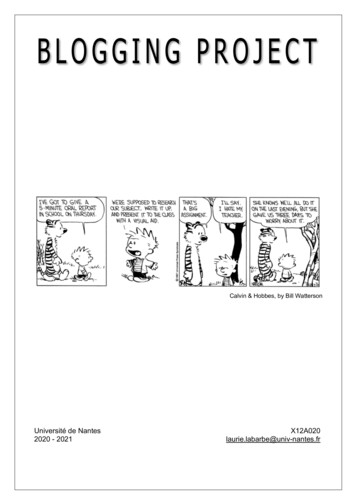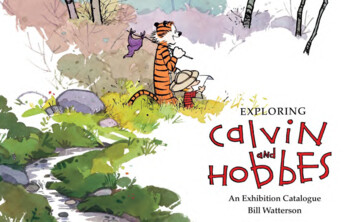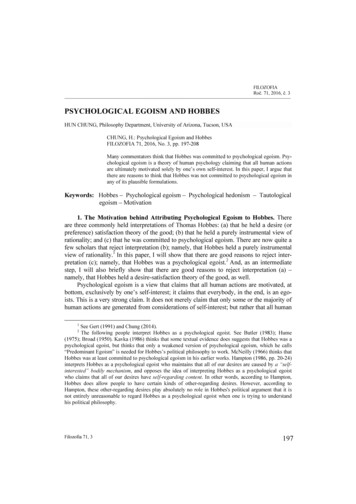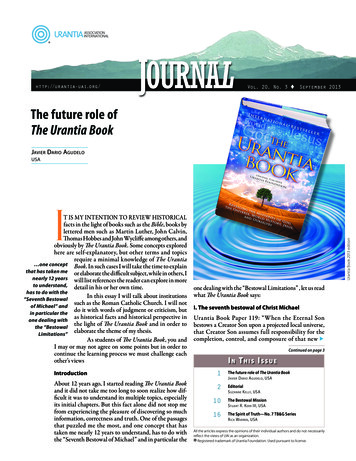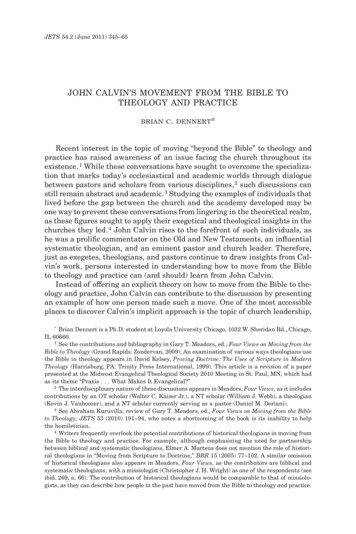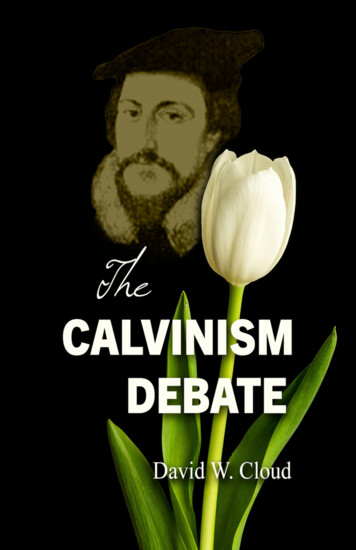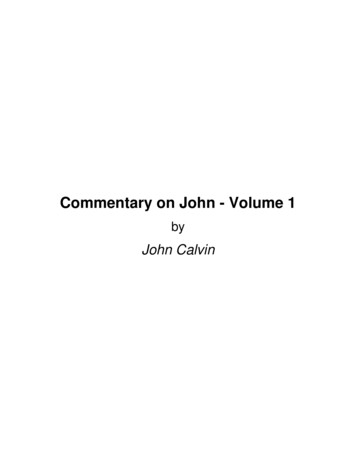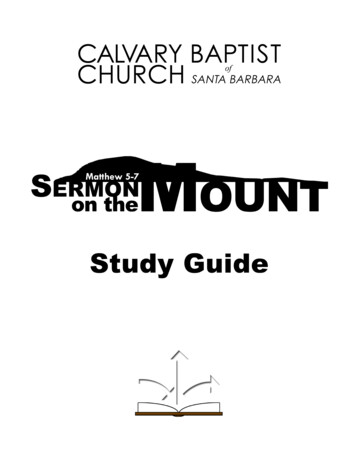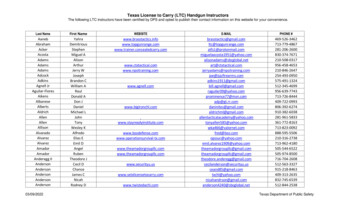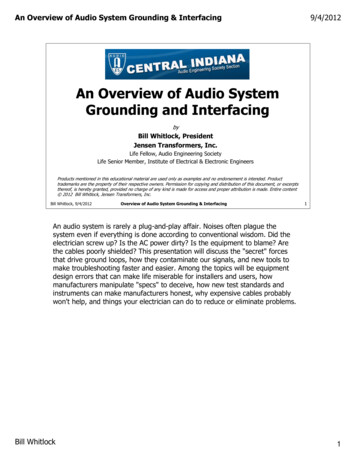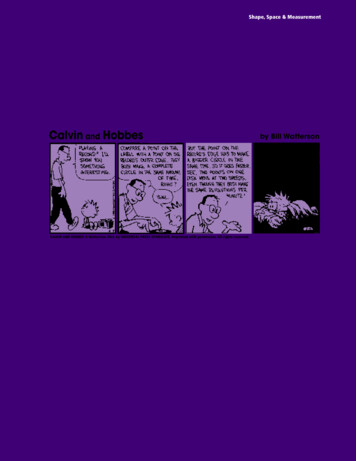
Transcription
Shape, Space & MeasurementCalvin and HobbesCALVIN AND HOBBES Watterson. Dist. by UNIVERSAL PRESS SYNDICATE. Reprinted with permission. All rights reserved.by Bill Watterson
S H A P E ,S P A C E&M E A S U R E M E N TLEARNING GOALStudents will developvisualization andreasoning skills byinvestigating space,measurement concepts,and axiomatic systems,using appropriate toolsand technologies.ComponentsWith this learning goal inmind, Minnesota studentswill have the opportunity to:1recognize, describe, andmodel shapes and relationships, and represent andreason about them inincreasingly abstract ways.2use transformations andconcepts of location, relativeposition, and symmetry tovisualize, represent, and verifygeometric relationships.3use measurement to make theconnection between numberand space in order to describe,analyze, model, and representreal world and abstractsituations.(For more detailed information, see pages 19-25 in thiscontent section.)2SciMathMN Minnesota K-12 Mathematics Framework
S H A P E ,S P A C E&M E A S U R E M E N TReflections“Properly developed, the study of shape can forma central component of mathematics education,a component that draws on and contributes tonot only mathematics but also the sciences andthe arts.”Senechal, 1990SciMathMN Minnesota K-12 Mathematics Framework3
S H A P E ,S P A C E&M E A S U R E M E N TReflections“ Spatial understandings are necessaryfor interpreting,understanding,and appreciatingour inherentlygeometric world.”NCTM, 1989Children play a video game and are not surprised that, as a space ship moves off the left side ofthe screen, it reappears at the same height on the right side. Rather than the movement happeningon a flat rectangular screen, it seems to be happening on a curved screen that meets itself - liketraveling around the label on a cylindrical can. But more is happening. As the ship climbs to the topof the screen, it reappears on the bottom in the corresponding position. This top-bottom movementis the same as the left-right movement so it might also be a viewed as cylindrical. Neither of thesesurprise the children because they are accustomed to what we call wraparound, which introducessome interesting implications in two-dimensional geometries. In mathematics the two-dimensionalfigure that fits both descriptions is shaped like an inner tube or donut and called a torus (see Figure 1). The torus is a two-dimensional surface embedded in a three-dimensional space whichdemands flexibility in thinking about shapes and dimensions. Understanding the nature of theshape, its properties and applications requires an organized approach—a geometry.Figure 1: from TheShape of Space [video].The Geometry Center,University of Minnesota. To sample moreabout geometry visitthe Geometry Center’swebsite at:www.geom.umn.edu/docs/forum/weeks“ The beauty of mathematics lies largely inthe interrelatednessof its ideas.”Cuoco, Goldenberg, &Mark, 1995Figure 1Problem solving, communication, reasoning, and connections, the first four NCTM standards, areidentified as permeating and underlying the entire curriculum. In many ways, geometry is anotherpervasive standard which forms a connection to many curricular areas. Geometry is rich in opportunities for students to be actively involved in doing mathematics. Exploration in shape and space isoften a child’s first positive mathematics experience. Geometry can support learning in other areasof mathematics by: building on children’s spatial capabilities to teach number skills and operations with base tenblocks using area models to understand fractions and percents, and to visualize probabilities(see Figure 2) moving backward and forward on a board game or a number line to form a geometric model forinteger operations building geometric models of algebraic operations (see Figure 3)Figure 2:This area model showsthe probability of getting at least one headwhen tossing 2 coins is3/4 or 75%.Figure 3:HHTHHHT3TTH4TTGeometric model of(L 2)(H 3)(W 4)Figure 24SciMathMN Minnesota K-12 Mathematics FrameworkHLFigure 32W
S H A P E ,“ involvement withconcepts of number,spatial configuration, andlogic, that is, implicit orexplicit mathematics, ispanhuman. In differentcultures, it arises withindifferent contexts.”Ascher & Ascher, 1981S P A C E&M E A S U R E M E N TBecause our world is geometric, the study of geometries can support topics in many areas such asscience, geography and the visual arts. Studying the formation of crystals in science involves geometry. Various geometric notions can also serve as resources for multicultural study. Shapes ofdwelling structures, use of pattern, symmetry, tessellations, and optical illusions all appear in a variety of curricular areas and cultures.Technical-scientific occupations (engineer, computer-assisted-designer, contractor, and architect)come readily to mind when thinking of practical applications of geometry. However, the ability tovisualize figures and mentally manipulate them is a basic geometric skill which supports work inmany fields. Truck drivers spend weeks training to develop the skill of backing a truck by looking ina side mirror. A tailor or dressmaker laying out a pattern will flip pieces and visualize fabricmatches. The statistician examines the “shape” of data.Geometry contains unifying themes that weave in and out through its fabric. One theme is thatof spatial sense. Researchers acknowledge its importance in interpreting the world and performingactions. Howard Gardner defined spatial intelligence as “the ability to form a mental model of aspatial world and to be able to maneuver and operate using that model,” identifying it as one ofthe intelligences of the human mind (Gardner, 1993, p. 9). Spatial sense includes both analyticalabilities and spatial abilities.Analytical abilities include: comparing, contrasting and identifying characteristics of shapes; rec-ognizing symmetry and relationships among shapes; and measurement. A young child fits twotriangular pattern blocks over a square pattern block or cuts a thin square prism to form two triangular prisms. This is a beginning decomposition model (Figure 4). At a later age the child recognizesmore complex decomposition like that of the cube in Figure 5. Measurement refines comparisonsbetween objects by comparing some attribute (distance, surface, volume, mass, time, temperature)to a standard, assigning a numerical value to the comparison. Measurement understanding develops from simple comparison of size (“This can is taller than this can”) and use of non-standard units(“It is three steps to the door from here”) to appreciation of the desirability of standardized units. Itis a topic rich in practical applications and cultural associations such as the Aztec calendar or construction of the Egyptian pyramids.deconstructedcubeFigure 4: A child beginsto form decompositionmodels by breaking asquare into two triangles.becomescubeFigure 5: The diagonaldecomposition of acube into congruentpyramids, a modelwhich can be built fromthree congruent templates.templateFigure 4Figure 5Spatial abilities are viewed by researchers as a variety of skills which may be grouped under twomain factors: visualization, which includes the ability to imagine how a shape or object will appearwhen it is moved or how a folded object will appear if unfolded flat, and orientation, which includes the ability to recognize a figure seen from different viewpoints or positions, includingcoordinate position.Another related theme is transformations. In primary grades students are introduced to transformations by sorting objects and looking for congruence and similarity. Nesting cubes and patternblocks can be used to develop these ideas while building geometric vocabulary. Translations, reflections, and rotations (commonly called slides, flips, and turns) are congruence-preservingSciMathMN Minnesota K-12 Mathematics Framework5
S H A P E ,“ Geometry is graspingspace that space inwhich the child lives,breathes and moves. Thespace that the child mustlearn to know, explore,conquer, in order to live,breathe, and move betterin it.”Freudenthal, 1973The van Hiele model ofgeometric thoughtproposes five levels ofunderstanding: visualization - can usevocabulary, identifyshapes, reproduce afigure analysis - can recognizeparts of figures andfigures by their parts informal deduction can interrelate properties between and withinfigures formal deduction - canunderstand deduction rigor - can work in avariety of systems andcan compare systemsBurger & Shaughnessy,1986; see also Fuys etal., 1988“ If we wait until studentshave developed a greatdeal of arithmetic sophistication (and a greatmany misconceptions)before we encouragethem to think about solidobjects and the interaction between differentdimensions, we may bedepriving them of thechance to appreciate thefull power and scope ofgeometry.”S P A C E&M E A S U R E M E N Ttransformations. These can start at a kinesthetic level using the child’s own body and progress using pattern block arrangements. Another type of transformation is a size change that enlarges orreduces objects while preserving angle measure. Such a transformation is a similarity transformation. The necessity of thinking in terms of reductions and enlargements has implications in manyareas for a society that deals with copy machines, computer images, microscopic viruses, and satellites functioning far from earth.Children have a natural interest in the three-dimensional world they inhabit. As infants, they beginto distinguish between themselves and other things; then between one thing and another. Theyform ideas about position and direction as they walk and run. Later these ideas can be extended todevelop deeper understandings of orientation in space (compass directions, Logo movements, andcoordinate systems). They learn to recognize that the ball they play with is pictured in their storybook by a circle, a beginning awareness of various dimensions. As students progress throughschool, they need to continue to develop their understanding of shape and space in an organizedfashion.How students mature in their geometric thinking has been researched and a model which has implications for classroom instruction was developed in the Netherlands by the van Hieles. The vanHiele research strongly supports the need to match instruction to students’ developmental levels intheir geometric thinking. If the student is at one level and instruction is at a different level, the mismatch will impede student understanding and progress. A mismatch occurs when middle schooland high school students, operating at the visualization level, are suddenly taught from a formallydeductive viewpoint (e.g., they are presented an axiomatic system of definitions and assumptionsand are expected to prove or disprove relationships within the system). At other times, the learningspiral flattens to a circle of repetitions of naming shapes and memorizing terminology and thebridge to working in an axiomatic system is not built. Students should engage in a wide variety ofgeometric experiences which are placed in context. Activities, materials, and language should setthe stage for further geometric understandings. “What do you see?” and “How do you know?” arerepeatedly asked questions, always with the purpose of moving students to a higher level of understanding.Much of children’s formal and informal learning is influenced by media sources. However, most ofthe media they are exposed to is two-dimensional: television, chalkboard, magazines, newspapers,books, movies, and calculator and computer screens. Much time is spent interpreting three-dimensional realities from their two-dimensional representations. The ability to move between dimensionsis a powerful tool to help students think abstractly, setting the stage for their explorations of otherdimensions (e.g., fourth dimension, fractal dimensions).As students move into the middle grades and high school, conclusions about geometric relationships are refined and verification moves from informal observation to demonstration by example toconjecture to computer demonstration to formal reasoning to proof. Students should connect algebraand geometry with multiple representations of transformations and with trigonometric concepts. Atthe high school level, the focus is on more than Euclidean systems and more than deductive proof.The focus includes giving increased attention to analysis of three-dimensional figures and continued development of the student’s ability to visualize, represent, and transform geometric figuresand their relationships working in non-Euclidean geometries.Banchoff, 1990To prepare the student for life work in a technological world, as well as for mathematics beyondhigh school, educators worldwide are recognizing that geometric preparation is just as importantas laying a firm foundation of algebraic understanding. This requires an expansion of geometrictopics with a focused sequence of study.6SciMathMN Minnesota K-12 Mathematics Framework
S H A P E ,S P A C E&M E A S U R E M E N TVignette: Shape, Space and Measurement in the ClassroomDon’t forget, I want each of you to bring an empty package from the supermarket tomorrow. It should be a rectangular prism and my advice is not to make it too large,” Ms. Davisreminded her middle school (grades 7 and 8) class before they went home from school.Next day most students brought their packages, mostly cereal boxes, cookie boxes, or boxed dinnerhelpers. One or two had forgotten, but Ms. Davis had anticipated this and brought in some extrasherself. She had also brought two packages she hoped to use later. These were of the same product, but one package held twice as much as the other. The plan for the morning was to dosomething as a class as a way of reviewing graphing skills, then move into group work and thenreview. Of course, there would be homework to assign. There were many materials like graph paper,tagboard, scissors, tape, glue, etc. out on the table so the class knew it would be another busymorning. Typical, if you had mathematics with Ms. Davis.“Good morning, class,” said Ms. Davis. “Have you all brought your rectangular prisms?”She gave out one of her extra boxes to each of the three people who had either forgotten orbrought a package which was rather large. (A box that was too large would be difficult to use forpart of the lesson.)Looking around the room it was interesting to see what packages had been brought into school. “Ifthose packages were full, we would have an interesting meal,” joked Ms. Davis. “Now then, Nina, whatpackage have you brought in?”“It’s a cereal box. We just finished a box of Blueberry Morning cereal,“ replied Nina. “It’s the13.5 ounce size. Actually, it is also 383 grams. I didn’t realize the packages were double marked.”“I expect most packages are,” said Ms. Davis. “Let’s have a look, shall we? You all have some graph paper on your tables. Use the one marked “Supermarket Packages, Grams: Ounces.” Look at the graphpaper and notice how it is marked. Along the bottom we have the weight in ounces and up the side wehave the weight in grams. Take a moment to look at the scales. Notice the division, and what each onestands for. Let’s take the Blueberry Morning which Nina said was 13.5 oz. and 383 grams. This is whatI want you to do. Find 13.5 on the ounces axis and go up to 383 on the grams axis, and put a dot wherethese two lines meet. Have you done that? Okay, let’s take another package.”Kesha called out, “My Raisin Bran is 25.5 ounces and 724 grams.”“Let me put that on my graph as you mark yours,” said Ms. Davis. “That’s 25.5 along the ounces and724 up the grams. Let’s plot some more. Mike, what weight is your container showing?”“I have a Golden Grahams cereal package and it weighed 16 ounces and 454 grams.”“Okay, everybody, that’s 16 along the horizontal and 454 on the vertical. Yes, Abby?”“These points seem to lie in a straight line!” exclaimed Abby.“Well, we will see. Let us put your package on the graph, Abby,” said Ms. Davis.“Mine is the Snack Well Crackers and it’s 7.5 along the x-axis and 213 up the y-axis. And theyseem to be on the same line. Are they all going to fit like that?” (Figure 1)SciMathMN Minnesota K-12 Mathematics Framework7
S H A P E ,S P A C E&M E A S U R E M E N TFigure 1 – Supermarket Packages — Grams: Ounces800Raisin Bran 700weight in grams600500Golden Grahms 400Blueberry Morning 300Snack Wells 2001000051015weight in ounces202530“We will see,” said Ms. Davis, as she asked all the others to call out their data which was plotted onthe graph.The students noticed that all the results ended up on a straight line.Ms. Davis had the class find the slope of the line to find the relationship between ounces andgrams. They found the slope to be about 28 (Figure 2). This was review work as the class had already found the slope of lines on different graphs. (The lines representing the multiplication tablesgot steeper as the multipliers got larger. This was a useful reference point especially when theylater plotted the diameter against the circumference of various cylindrical containers because they“felt” the slope was between 3 and 4. They had looked at the price of peanut butter over the yearsand found it had gone up! So had cornflakes and the price of cars. Some prices went up faster thanothers. Some graphs looked like lines, other were not linear.)Figure 2 – Supermarket Packages — Grams: Ounces800Raisin Bran 700weight in grams600500Golden Grahms 400Blueberry Morning 300Snack Wells 2001000051015weight in ounces202530The review part of the lesson over, Ms. Davis then moved to the main part of the lesson.“You all brought in a rectangular prism and as I look around the class I see that they are all different. Wehave a number of cereal boxes but no two are the same. That’s perfect. It couldn’t be better. You knowthey are called rectangular prisms but I wonder if anyone can define a rectangular prism? What do youthink?”“It is a solid shape.”“You can pick it up.”8SciMathMN Minnesota K-12 Mathematics Framework
S H A P E ,S P A C E&M E A S U R E M E N T“You can pick up a Coke can, but it’s not a rectangular prism.”“I know that, but a Coke can is a prism.”“No, it isn’t. It’s a cylinder.”“But a cylinder is a prism.”Ms. Davis decided she had better intervene. “Can anyone remember what a prism is in mathematics?”The class spent a minute discussing the point. They said what a prism was and what it was not.John said that if you could stack a solid shape one on top of the other and still have the sameshape at the end, although it would be larger, then the shape was a prism. Ms. Davis felt the students showed an understanding of a prism being a solid with uniform cross sectional area. Finallythey had a pretty good idea and felt confident with their understandings.“So, a cylindrical Coke can is a circular prism.”“Yes, if we forget the indentation at the top,” said Ms. Davis, who was eager to move on. “Tell memore about our rectangular prisms.”“They all have six faces.”“They all have twelve edges.”“And they have eight corners.”“Vertices,” advised Ms. Davis. “Now tell me something about the faces and edges.”“The faces are different. No! My rectangular prism has three pairs of different faces.”“The opposite sides are the same size.”“Mine hasn’t got three different faces, but the opposite faces are the same.”Time for Ms. Davis again. “Hold your prism up, Tia, for us all to see. Ah. What shape are the faces onyour package, Tia?”“Four are rectangular and the same, and two are square.” (Ms. Davis chose not to be sidetrackedhere about a square being a rectangle.)“Then you have a special rectangular prism. It is a square prism. What was inside, Tia? Crackers?”“No, thin chocolate mints.”“Mmm. Sounds good. We will all join you for a chocolate square prism after lunch!”The class explored the geometry of their boxes, noticing the right angles and lines (creases) andsurfaces. Opening the boxes and laying them out flat was interesting. They were quite surprised athow many right angles they could see. But whatever the size of their individual box, there were certain common features.“Now, you can see why I suggested you didn’t bring too large a box. You can see how much cardboardwas used to make them. Here is what I want you to do: Make a box which will hold twice as much asyour original box. There is a little bit more information I will give you before you start but can we justthink about that for a minute? Fold up your boxes again and let’s discuss the problem in groups.”SciMathMN Minnesota K-12 Mathematics Framework9
S H A P E ,S P A C E&M E A S U R E M E N TThe class moved into their discussion groups to discuss the problem. After a while the class cametogether again.“Who has an idea?” asked Ms. Davis.“We basically have six rectangular faces so we can find the amount of material used for our box.”“And the volume can be calculated as well. So we can double this to know what the volume of ournew box should be.”“If we had two boxes the same, we could place one on top of the other to have twice the volume.”“That would be bulky, or long, especially with the cereal boxes. You couldn’t see over the top of it atbreakfast!”“Cool! I wouldn’t have to look at my little sister. But to double the volume, we need to increase thelengths of the sides somehow.”“Can I ask you to think about that?” interjected Ms. Davis.“If we double all the lengths, the box will be far too big. It would be eight times as large as theoriginal one.”“If we double two of the sides, it will still be too big.” (Ms. Davis would return to this later.)“So the only way is to double one of the sides, but we have three sides to choose from, except forTia.”Ms. Davis had anticipated this and explained that doubling one side was not the only way todouble the volume. To demonstrate her point, she produced two packages of chocolates where oneheld twice the other, but where all three dimensions had changed.“Here is a pair of empty boxes. This one holds twice the other one and you can see all the dimensionshave changed and they are not double the original ones, are they? Perhaps we should examine this onetogether. I will pass them round the groups. What can we find out?”“The larger package holds 1 pound, that is 16 ounces. It also says it holds 454 grams. We have hadthat before, haven’t we?”“And the smaller package does hold half, because 8 is half of 16 and 227 is half of 454.”“And the matching sides are not double. In fact, they are only a little bit longer.”“We need to look at the relationship between the lengths on each box,” said Ms. Davis. “Let’s do somemeasuring and collect some data.”As there was only one sample to work on, the groups passed the two boxes around and took onemeasurement in each group. They measured the length of the base on each box, the height of eachbox, the width of each box, and the diagonals of two different faces on both boxes. These weretheir results as measured in centimeters:10LengthHeightWidthDiagonalof large faceDiagonalof small faceLarge box10197.521.512.5Small box81561710SciMathMN Minnesota K-12 Mathematics Framework
S H A P E ,S P A C E&M E A S U R E M E N T“So what is the relationship between these two data sets?” prompted Ms. Davis.The children graphed the points and found the slope was about 1.26. (Figure 3)Figure 3 – Package Dimensions – Volume Doubledlarge box dimensions2520151050024681012141618small box dimensions“That means all we need to do is to increase the key lengths on our boxes by a factor of 1.26 and weshould get our new box. Next time you go to the supermarket, look for some boxes where one holdstwice the other and see whether the sides are about a quarter as much again. 1.26 is about 1-1/4.”“Now I want you to make a box which holds twice your original box, but where you change all three dimensions. I want you to show me mathematically that it does hold twice your original box AND I wantyou to tell me how much more material you used to make this box compared to the original. I want youto state the ratio between the small box and the large box as far as material used. Is that clear? Yes, youcan help each other, but I do need a box from each of you. Put your paper explaining what you havedone and why it works inside your original box; then put the original box inside your new box. Remember to include the ratio of the amount of material used in each box.”They all produced their boxes and Ms. Davis called them together to summarize.“How did the Blueberry Morning package work out, Nina?”“I saved material. It didn’t take twice as much cardboard to make a package twice the size.”Nina showed the class her box and her paper.My original box had dimensions of length 17 cm., width 5 cm., and height 25 cm. To find the volume, I multiply my three dimensions. It had a volume of about 2125 cu. cm. Its surface area wasabout 1270 sq. cm. because I have six rectangular faces, in three pairs. The area of a 17 cm by 5cm face is 17 x 5. Then I multiply by 2 because there are two of them. I do that for each pair andthen add the results together to get total surface area.(17 x 5 x 2) (17 x 25 x 2) (5 x 25 x 2) 1270 sq. cm.My new box had the following measurements:length (17 x 1.26) 21.42 cm.width (5 x 1.26) 6.3 cm.height (25 x 1.26) 31.5 cm.Its volume: 21.42 x 6.3 x 31.5 4251 cu. cm. which is just about twice the original.The surface area : (21.42 x 6.3 x 2) (21.42 x 31.5 x 2) (31.5 x 6.3 x 2) 2016 sq. cm.To find the ratio, I used my calculator to divide the new area by the original. I rounded to hundredths. Ratio 2016/1270 1.59SciMathMN Minnesota K-12 Mathematics Framework11
S H A P E ,S P A C E&M E A S U R E M E N TThis means I used about 60% more material to make a box twice the size when all three dimensions are changed.“So, Nina, you used about 60% more material. How did the rest of you do?”“Hey, I got 60%, too.”John said, “I didn’t understand what ratio meant so I decided to work out how many times my oldsurface area would fit into my new surface area. I thought it would be two times, but that wasn’tso. That was obvious. So I divided because it seemed to be like these division models we did whenwe found how many 8 inch lengths of ribbon we could cut from a longer length, or like when wethought about working out ‘There are 126 trick or treat candies. If I put 9 in a bag, how many bagswould I fill?’ So I divided and I got 1.59. That’s about 60% �59%.”“Did you all use the same box to start with?” asked Ms. Davis.“NO, they were all different but our results are the same. Are you a magician, Ms. Davis?”“Here’s your homework paper. Be sure to take two pieces of isometric paper with you for your sketches.”Homework that night had students practice some surface area problems and make a sketch (notanother box!) to see how it looked. As usual in Ms. Davis’ assignments, there was something todiscover in the homework. The questions were designed to show that all the packages had thesame volume, but a different surface area. (See Homework sheet that follows vignette.)Ms. Davis was pleased with the lesson. She was prepared in the next lesson to make the connection from this work to the square and cube roots of 2. By drawing the homework sketches to scaleon isometric paper, (Figure 4), the students would see that the most material-efficient shapes werethe ones like the squat rectangular boxes used for many brands of ice cream. In a future lesson thestudents would see that a box with the minimum surface area will have minimum heat loss—moreimportant when you store ice cream than when you store cornflakes!.Figure 4.15 cm.“I think this style is most efficient because it has less surface area.”.12SciMathMN Minnesota K-12 Mathematics Framework.16cm.surface. .area. 2cm.1410.volume. . 3.3600.cm. cm.15.
S H A P E ,S P A C E&M E A S U R E M E N THomework:Find both the volume and surface area of the following packages:All measures are in 1115122012151516SciMathMN Minnesota K-12 Mathematics FrameworkVolumeSurface Area13
S H A P E ,S P A C E&M E A S U R E M E N TReality Check: Shape, Space and Measurement in the WorkplaceJoe C. is a “Designer’s Best Friend” — which is also the name of his upholstery business.One of Joe’s specialties is custom-made slipcovers, made to fit old couches or chairs. They cost lessthan new furniture, and help to spruce up a home.Shapes in the realworld are sketched,drawn, modeled, andtransformed, usingspatial visualizationand concepts of congruence, symmetry,and similarity.To sew these slipcovers, Joe needs to go from three dimensions (the couch, for example ) to two dimensions (the flat piece of fabric), and back to three dimensions (to the slipcover). In doing so, heuses concepts and tools of space, shape, and measurement.To make a slipcover, Joe makes a paper pattern from the furniture. He often needs to fit curves, forwhich he may use his eye or a French curve template. He brings the pattern back to the shop wherea cutter matches the fabric to the pattern. She determines the best way to place the pattern on thefabric, which depends on whether there is a repeated design in the material (such as flowers orstripes) and how close the fabric pattern repeats. She may also have to match a lining to the slipcover or skirt. Joe says, “People are amazed to see me leave with a piece of paper and return withperfectly fitting slipcovers.”Since every slipcover is custom-made,
books, movies, and calculator and computer screens. Much time is spent interpreting three-dimen-sional realities from their two-dimensional representations. The ability to move between dimensions is a powerful tool to help students think abst
